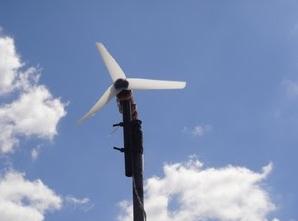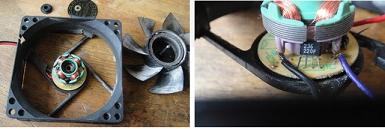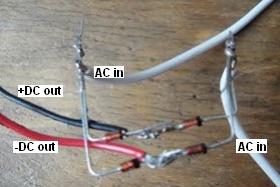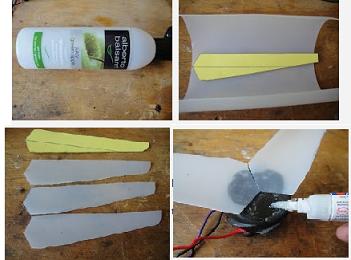
Any used PC fan can be used for this project though the bigger the better for maximum power output from the finished wind turbine generator. After dismantling the fan, two thin pieces of cable are soldered to the fan’s copper coil outputs.

These give AC voltage when the fan is spun. In order to get DC voltage for battery charging, powering some LEDs, powering a radio etc, the AC voltage must first be rectified to DC using a bridge rectifier – either something like this: W005 1.5A bridge rectifier, or you can Make a Bridge Rectifier with Diodes.
To minimise the voltage dropped (and wasted as heat) in the bridge rectifier, if you make your own, it is best to use either schottky diodes or germanium diodes as these have half the voltage drop of standard silicon diodes. The bridge rectifier built by Chris utilised Schottky diodes and is pictured below.

Chris used BAT85 Schottky signal diodes (available here: BAT85 Schottky diodes for around 5-10p each). There are rated to 200mA which should be more than enough for this wind turbine which only generates tens of mA of current. For a larger fan with larger turbine blades than those shown and described below, diodes with a higher current rating must be used.

For this wind turbine the turbine blades are made from a used (and well washed out) bleach bottle since these bottles are made of thicker plastic than standard drink bottles. With the blade shapes cut out of the bottle and glued to the hub of the motor, and the motor glued to a piece of wood with an old CD used as a tail to help the turbine follow the wind direction, the wind turbine is finished.
Here is a video of the finished wind turbine generator in action:
You can only expect to get a couple of volts out of a PC fan converted in this way, but that is enough to trickle charge a single AA or AAA NiMH rechargeable cell. To increase the voltage – for example to charge a higher voltage cell or battery – the AC from the fan can be passed through a voltage doubler or multiplier (which also acts as a rectifier) giving a higher voltage (but lower current) DC output.
More Information and Detailed Plans
Click here to read the full article Upcycle PC Fan on the Scrap to Power website – a site which presents clear detailed photo-illustrated instructions for a selection of alternative energy projects, primarily Stirling engines.